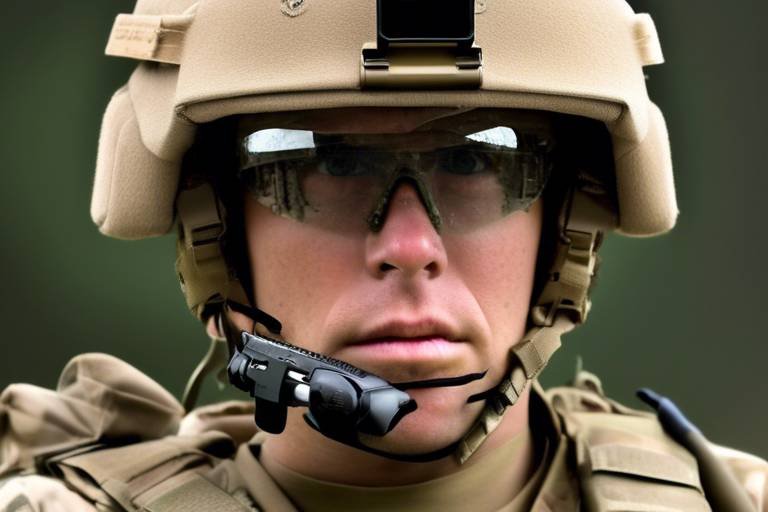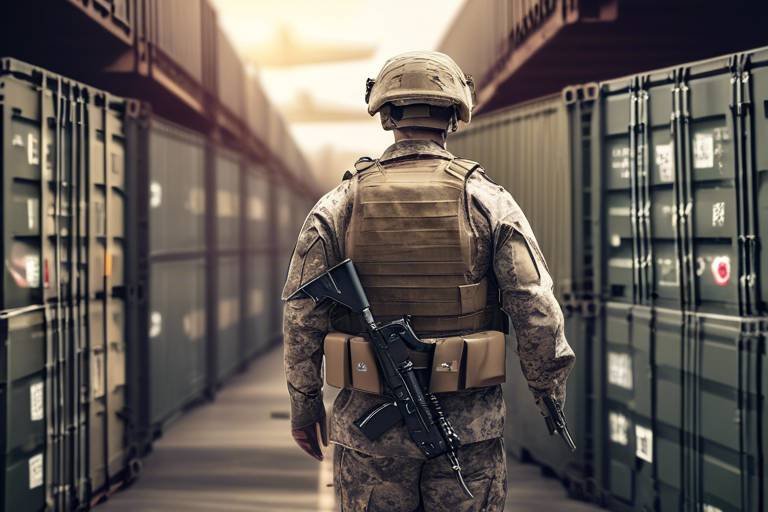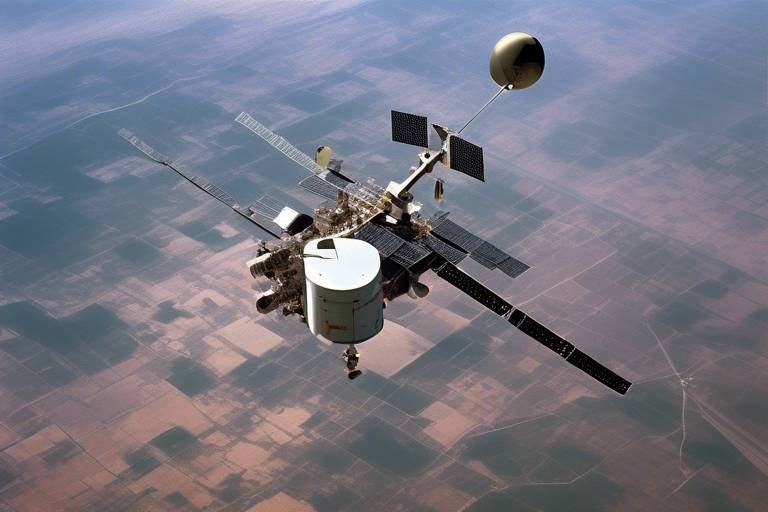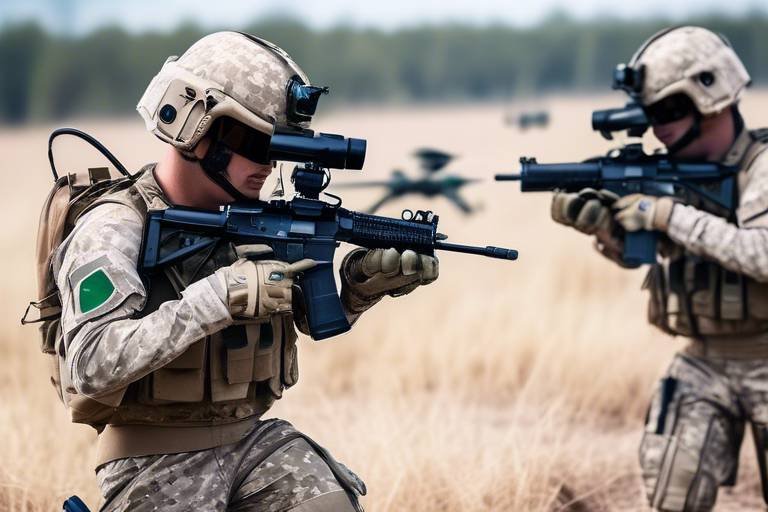The Impact of AI on Military Logistics Management
In recent years, the military has witnessed a revolution in its operational capabilities, largely driven by the integration of artificial intelligence (AI) into its logistics management systems. This transformation is not just about enhancing efficiency; it's about fundamentally changing how military operations are planned and executed. Imagine a world where supply chains are managed with the precision of a well-oiled machine, where decision-making is informed by real-time data, and where the ability to adapt to rapidly changing conditions is second nature. That's the power of AI in military logistics.
The role of AI extends beyond mere automation; it encompasses a comprehensive approach to logistical challenges. From predictive analytics that forecast supply needs to autonomous vehicles that deliver critical supplies, AI technologies are enhancing operational capabilities while allowing military leaders to focus on strategy rather than mundane logistics tasks. This isn't just about speed; it's about creating a resilient supply chain that can withstand the chaos of modern warfare.
However, the integration of AI into military logistics is not without its challenges. Issues such as data quality, integration of various systems, and the need for skilled personnel to interpret complex models can create bottlenecks. Yet, the potential benefits far outweigh these hurdles. By leveraging AI, military organizations can achieve a level of operational readiness that was previously unimaginable. For instance, consider the impact of AI-driven decision support systems that analyze vast amounts of data in real time, providing military leaders with actionable insights that can make the difference between success and failure in critical missions.
As we look to the future, the trends in military logistics suggest an increasing reliance on AI technologies. This includes enhanced collaboration with commercial logistics providers, which can bring additional expertise and efficiency to military operations. The integration of advanced technologies will not only improve operational effectiveness but also ensure that military logistics can adapt to the evolving landscape of warfare. However, as we embrace these advancements, it's crucial to consider the ethical implications of AI in military settings, particularly regarding data privacy and the accountability of automated decision-making processes.
- What is military logistics?
Military logistics refers to the planning, execution, and management of supply chains, transportation, and maintenance to ensure that armed forces are properly equipped for operations. - How does AI improve military logistics?
AI enhances military logistics by streamlining processes, optimizing supply chain management, and providing real-time data analysis to support decision-making. - What are the challenges of implementing AI in military logistics?
Challenges include data quality issues, the integration of various systems, and the need for skilled personnel to interpret complex AI models. - What future trends can we expect in military logistics?
Future trends include increased reliance on AI, collaboration with commercial logistics providers, and the integration of advanced technologies for improved operational effectiveness.

Understanding Military Logistics
Military logistics is a critical component of any armed force's operational capability. It involves the intricate planning, execution, and management of supply chains, transportation, and maintenance. Think of military logistics as the backbone of the military, ensuring that troops are not only equipped but also ready to engage in operations at a moment's notice. Without effective logistics, even the most advanced military technology would be rendered useless. It's like trying to run a marathon without having trained properly; no matter how good your shoes are, you're likely to stumble.
At its core, military logistics is about more than just moving goods from point A to point B. It encompasses a wide range of activities, including:
- Supply Chain Management: This involves the coordination of resources, from ammunition to food supplies, ensuring that everything is available when and where it is needed.
- Transportation: The movement of troops and equipment is crucial, whether by land, air, or sea. Each transport method has its own challenges and benefits.
- Maintenance: Keeping equipment in top condition is vital. This includes regular checks, repairs, and upgrades to ensure that military assets are always operational.
The importance of military logistics cannot be overstated. It directly impacts the success of missions and the safety of personnel. If supplies run low or if equipment fails, the consequences can be dire. Imagine a scenario where troops are in the field, and their supplies of food, water, or ammunition are delayed. This not only affects their operational effectiveness but can also jeopardize their safety. Therefore, having a robust logistics framework is essential for any military operation.
Furthermore, military logistics is constantly evolving. With the advent of new technologies and methodologies, logistics teams are now able to operate with increased efficiency. For instance, the integration of artificial intelligence (AI) and data analytics is transforming how logistics are managed. These technologies allow for real-time tracking of supplies, predictive maintenance of equipment, and more efficient routing of transportation. As military operations become more complex and dynamic, adapting logistics strategies to meet these challenges is crucial.
In summary, military logistics is a multifaceted discipline that plays a pivotal role in the effectiveness of armed forces. By ensuring that resources are available and operational, logistics not only supports military missions but also enhances overall readiness and resilience. As we look toward the future, the integration of advanced technologies will only amplify the importance of logistics in military operations.

Role of AI in Logistics
The integration of artificial intelligence (AI) into military logistics is nothing short of revolutionary. Imagine a world where logistical challenges are met with swift, data-driven solutions, enhancing the overall efficiency of military operations. AI technologies streamline logistics processes, optimize supply chain management, and enhance decision-making capabilities—allowing military organizations to respond swiftly to dynamic operational environments. This transformation not only saves time but also significantly reduces costs, ultimately ensuring that armed forces are always ready for action.
One of the most significant contributions of AI in logistics is its ability to analyze vast amounts of data at lightning speed. Traditional methods often rely on manual analysis, which can be time-consuming and prone to human error. In contrast, AI systems can process real-time data from various sources, such as satellite imagery, sensor data, and historical records, to deliver actionable insights. This capability allows military leaders to make informed decisions based on current conditions rather than outdated information.
For instance, consider the logistics involved in a large-scale military operation. AI can evaluate multiple factors—like weather conditions, troop movements, and supply levels—to predict the best routes for transportation. This kind of predictive analysis is invaluable, as it not only speeds up the logistics process but also ensures that resources are allocated efficiently. By leveraging AI, military planners can anticipate potential bottlenecks and address them proactively, leading to smoother operations.
Furthermore, AI plays a crucial role in inventory management. By employing machine learning algorithms, military logistics can maintain optimal inventory levels, ensuring that supplies are available when and where they are needed. This capability is particularly important in high-stakes situations where delays can lead to mission failure. AI systems can forecast demand based on various parameters, allowing for timely restocking and reducing the risk of shortages.
However, it’s essential to acknowledge that the role of AI in logistics is not without its challenges. The effectiveness of AI systems heavily depends on the quality of the data fed into them. Poor data quality can lead to inaccurate predictions, which can have dire consequences in military operations. Additionally, integrating AI into existing logistics frameworks requires skilled personnel who can interpret complex models and ensure that the systems are functioning correctly.
In summary, the role of AI in military logistics is transformative and multifaceted. It enhances operational readiness, improves decision-making processes, and optimizes supply chain management. As military organizations continue to embrace these technologies, the potential for increased efficiency and effectiveness in logistics operations becomes even more promising.
- How is AI improving military logistics? AI enhances military logistics by streamlining processes, optimizing supply chains, and enabling quicker decision-making through real-time data analysis.
- What are the challenges associated with AI in logistics? The main challenges include data quality, integration with existing systems, and the need for skilled personnel to manage and interpret AI models.
- Can AI predict future supply needs? Yes, AI uses predictive analytics to forecast demand and optimize inventory levels based on various data sources.
- What technologies are involved in AI-driven logistics? Technologies include machine learning algorithms, robotics, autonomous vehicles, and real-time data processing systems.

Predictive Analytics
This article explores how artificial intelligence is transforming military logistics, enhancing efficiency, decision-making, and operational capabilities while addressing challenges and future implications for defense systems.
Military logistics encompasses the planning, execution, and management of supply chains, transportation, and maintenance, ensuring that armed forces are equipped and ready for operations.
AI technologies streamline logistics processes, optimize supply chain management, and enhance decision-making, enabling military organizations to respond swiftly to dynamic operational environments.
Predictive analytics is revolutionizing the way military logistics operates, acting as a crystal ball that helps commanders foresee future demands and challenges. By utilizing complex algorithms and vast datasets, predictive analytics can forecast everything from supply needs to maintenance schedules. Imagine having the ability to predict a storm before it hits; that’s what military logistics can achieve with AI. This not only boosts operational readiness but also significantly cuts costs by minimizing waste and ensuring that resources are allocated where they are needed most.
To achieve effective predictive analytics, various data sources are leveraged. These include:
- Historical Performance: Analyzing past data to identify trends and patterns.
- Real-Time Sensor Data: Gathering information from equipment and vehicles to assess current conditions.
- Environmental Factors: Considering weather, terrain, and other external influences that may affect logistics.
However, the road to effective predictive analytics is not without its bumps. One of the primary challenges is ensuring high data quality. If the data fed into the system is inaccurate or outdated, the predictions will be flawed, leading to potentially disastrous consequences. Furthermore, integrating data from various sources can be a complex task, requiring sophisticated systems and skilled personnel capable of interpreting intricate models. The military must invest in training and technology to overcome these hurdles.
Despite its transformative potential, predictive analytics in military logistics faces several hurdles:
- Data Quality: Poor data quality can lead to inaccurate predictions.
- Integration Issues: Combining data from diverse sources can be challenging.
- Need for Expertise: Skilled personnel are essential to interpret complex data models effectively.
In summary, predictive analytics is a powerful tool that, when implemented correctly, can significantly enhance military logistics. It enables armed forces to be not just reactive but proactive, ensuring that they are always a step ahead in the ever-evolving battlefield.
AI-driven decision support systems assist military leaders in making informed logistical decisions by analyzing vast amounts of data, evaluating scenarios, and providing actionable insights.
Real-time data processing enables military logistics to adapt quickly to changing conditions, ensuring timely delivery of supplies and resources to operational units.
Scenario simulation tools help military planners visualize potential logistics challenges and outcomes, facilitating better preparedness and strategic planning for future missions.
Emerging trends in military logistics include increased reliance on AI, enhanced collaboration with commercial logistics, and the integration of advanced technologies to improve operational effectiveness and resilience.
Collaboration with commercial logistics providers enhances military supply chains, leveraging their expertise and technology to improve efficiency and reduce costs.
As AI continues to shape military logistics, ethical considerations surrounding data privacy, decision-making accountability, and the implications of automation on the workforce must be addressed.
- What is predictive analytics in military logistics?
Predictive analytics uses historical data and algorithms to forecast future logistics needs, helping military organizations prepare effectively. - What are the main challenges of implementing predictive analytics?
Challenges include ensuring data quality, integrating diverse data sources, and the need for skilled personnel to interpret complex models. - How does AI improve decision-making in military logistics?
AI analyzes vast amounts of data to provide actionable insights, enabling military leaders to make informed decisions quickly.

Data Sources for Prediction
In the realm of military logistics, the accuracy of predictive analytics hinges on the quality and variety of data sources utilized. By harnessing a multitude of data streams, military organizations can fine-tune their operational strategies and ensure that resources are allocated effectively. The primary data sources can be categorized into several distinct types:
- Historical Performance Data: This includes records of past logistics operations, detailing everything from supply chain efficiency to equipment maintenance schedules. Analyzing historical data helps military planners identify patterns and trends that can inform future decision-making.
- Real-Time Sensor Data: Modern military operations rely heavily on real-time data collected from various sensors embedded in vehicles, equipment, and even personnel. This information provides up-to-the-minute insights into the status of supplies and equipment, allowing for swift adjustments as needed.
- Environmental Factors: External conditions such as weather patterns, terrain characteristics, and geopolitical climates can significantly impact logistics operations. By integrating environmental data into predictive models, military planners can anticipate challenges and devise contingency plans.
Moreover, the convergence of these data sources enables a more holistic approach to logistics management. For instance, when historical performance data is combined with real-time sensor data, military organizations can create a dynamic picture of their operational landscape. This synergy not only enhances predictive accuracy but also fosters a proactive stance in logistics planning.
However, it’s important to note that the integration of diverse data sources is not without its challenges. Data quality and consistency are paramount; if the data is flawed or outdated, the predictions derived from it will likely be unreliable. Additionally, the sheer volume of data generated can be overwhelming, necessitating advanced analytical tools and skilled personnel who can interpret complex models effectively.
As military logistics continues to evolve, the emphasis on utilizing robust and varied data sources will only grow stronger. By embracing innovative data integration strategies, military organizations can enhance their operational readiness and ensure that they are always one step ahead in the ever-changing landscape of defense logistics.
- What is predictive analytics in military logistics? Predictive analytics involves using historical and real-time data to forecast future logistics needs, optimize inventory, and improve operational readiness.
- How does real-time sensor data enhance logistics management? Real-time sensor data provides immediate insights into the status of supplies and equipment, allowing for quick adjustments to logistics operations.
- What challenges are associated with data integration in military logistics? Challenges include ensuring data quality, managing large volumes of data, and the need for skilled personnel to analyze complex datasets.
- Why are environmental factors important in logistics predictions? Environmental factors can significantly impact logistics operations, and understanding these conditions helps military planners anticipate potential challenges.

Challenges in Predictive Analytics
This article explores how artificial intelligence is transforming military logistics, enhancing efficiency, decision-making, and operational capabilities while addressing challenges and future implications for defense systems.
Military logistics encompasses the planning, execution, and management of supply chains, transportation, and maintenance, ensuring that armed forces are equipped and ready for operations.
AI technologies streamline logistics processes, optimize supply chain management, and enhance decision-making, enabling military organizations to respond swiftly to dynamic operational environments.
Predictive analytics in military logistics allows for forecasting demand, optimizing inventory levels, and anticipating maintenance needs, thereby improving overall operational readiness and reducing costs.
Various data sources, including historical performance, real-time sensor data, and environmental factors, contribute to accurate predictive analytics, ensuring effective resource allocation and planning.
Despite the immense potential of predictive analytics in military logistics, several challenges must be navigated to fully harness its capabilities. One of the primary issues is data quality. Inaccurate or incomplete data can lead to flawed predictions, which may result in misallocated resources or missed opportunities. Imagine trying to predict the weather with outdated information; the consequences can be dire. Similarly, military operations hinge on the precision of data collected from various sources.
Another significant hurdle is data integration. Military logistics involves an array of data streams, from historical records to real-time sensor outputs. Integrating these diverse data sources into a cohesive analytical framework can be complex and time-consuming. If different systems cannot communicate effectively, the predictive models may lack the comprehensive view necessary for accurate forecasting.
Furthermore, the demand for skilled personnel to interpret complex models cannot be overstated. The military must invest in training or hiring data scientists who can navigate the intricacies of predictive analytics. Without the right talent, even the most sophisticated algorithms can fall flat, much like having a top-notch sports car without a skilled driver behind the wheel.
Lastly, ethical considerations surrounding data privacy and security pose additional challenges. As military organizations increasingly rely on predictive analytics, they must ensure that sensitive information is protected against breaches and misuse. Balancing the need for data-driven insights with the imperative to safeguard personal and operational data is a tightrope walk that requires careful attention.
Automation technologies, including robotics and autonomous vehicles, enhance supply chain efficiency by reducing human error, speeding up processes, and increasing the reliability of logistics operations.
AI-driven decision support systems assist military leaders in making informed logistical decisions by analyzing vast amounts of data, evaluating scenarios, and providing actionable insights.
Real-time data processing enables military logistics to adapt quickly to changing conditions, ensuring timely delivery of supplies and resources to operational units.
Scenario simulation tools help military planners visualize potential logistics challenges and outcomes, facilitating better preparedness and strategic planning for future missions.
Emerging trends in military logistics include increased reliance on AI, enhanced collaboration with commercial logistics, and the integration of advanced technologies to improve operational effectiveness and resilience.
Collaboration with commercial logistics providers enhances military supply chains, leveraging their expertise and technology to improve efficiency and reduce costs.
As AI continues to shape military logistics, ethical considerations surrounding data privacy, decision-making accountability, and the implications of automation on the workforce must be addressed.
- What is predictive analytics in military logistics? Predictive analytics involves using data to forecast demand, optimize inventory, and anticipate maintenance needs, enhancing operational readiness.
- What are the main challenges of implementing predictive analytics? Key challenges include data quality, integration issues, the need for skilled personnel, and ethical concerns regarding data privacy.
- How does AI improve decision-making in military logistics? AI analyzes vast amounts of data to provide actionable insights, helping military leaders make informed logistical decisions quickly.
- What role do commercial logistics play in military operations? Collaboration with commercial logistics providers allows military organizations to leverage advanced technologies and expertise, improving overall efficiency.

Automation in Supply Chains
When we think about military logistics, the concept of automation in supply chains stands out as a game-changer. Imagine a world where the movement of supplies is not just efficient but also remarkably precise, almost like a well-choreographed dance. Automation technologies, including robotics and autonomous vehicles, are transforming how military operations manage their logistics. These innovations are not merely enhancements; they are revolutionizing the entire logistics framework, allowing for a seamless flow of resources.
One of the most significant advantages of automation is the reduction of human error. In high-pressure environments, mistakes can be costly, even fatal. By integrating automated systems, military logistics can ensure that supplies are delivered accurately and on time, minimizing the risk of errors that could jeopardize missions. For instance, autonomous vehicles can navigate complex terrains without the need for human drivers, which not only speeds up the delivery process but also ensures that personnel are freed up for more critical tasks.
Moreover, automation enhances the speed of logistics operations. With the ability to process and analyze data in real-time, automated systems can make instantaneous decisions, allowing military units to adapt to changing circumstances. This capability is especially crucial during operations where timing is everything. Picture a scenario where a unit needs immediate supplies; automated systems can respond faster than traditional methods, ensuring that troops have what they need when they need it.
However, the journey towards full automation is not without its challenges. Implementing these advanced technologies requires significant investment and training. Military organizations must not only acquire the latest robotics and autonomous systems but also ensure that their personnel are equipped with the skills to operate and maintain these technologies effectively. This brings us to an essential aspect of automation: the need for a robust infrastructure and a skilled workforce.
To illustrate the impact of automation in military supply chains, consider the following table that highlights some of the key benefits and challenges:
| Benefits of Automation | Challenges of Automation |
|---|---|
| Increased efficiency in logistics operations | High initial investment costs |
| Reduction in human error | Need for skilled personnel |
| Faster response times | Integration with existing systems |
| Enhanced supply chain visibility | Potential resistance to change from personnel |
As we look to the future, the role of automation in military logistics will only continue to grow. The integration of advanced technologies promises to enhance operational effectiveness and resilience, making the military more agile and responsive to threats. The challenge lies in ensuring that these systems are implemented thoughtfully and ethically, taking into account the implications for the workforce and the importance of maintaining accountability in decision-making.
- What are the primary benefits of automation in military logistics?
Automation in military logistics leads to increased efficiency, reduced human error, faster response times, and enhanced supply chain visibility.
- What challenges does automation face in military logistics?
Challenges include high initial investment costs, the need for skilled personnel, integration with existing systems, and potential resistance to change from personnel.
- How do autonomous vehicles improve military logistics?
Autonomous vehicles can navigate complex terrains without human drivers, speeding up the delivery process and allowing personnel to focus on critical tasks.
- What is the future of automation in military logistics?
The future of automation in military logistics looks promising, with ongoing advancements in technology expected to further enhance operational effectiveness and resilience.

AI-Driven Decision Support Systems
In the ever-evolving landscape of military logistics, have emerged as game-changers. These systems are not just tools; they are the backbone that helps military leaders navigate the complex web of supply chains and operational demands. Imagine being in a high-stakes situation where every second counts. Wouldn't it be invaluable to have a system that can sift through mountains of data and provide actionable insights in real-time? That's precisely what AI brings to the table!
These systems leverage advanced algorithms and machine learning to analyze vast amounts of data, from historical logistics performance to real-time supply chain metrics. This capability allows military planners to make informed decisions quickly, ensuring that resources are allocated efficiently and effectively. For instance, when faced with an unexpected operational requirement, a decision support system can analyze current inventory levels, predict future needs, and suggest optimal supply routes—all in the blink of an eye. This kind of agility is crucial in modern warfare, where the battlefield can change in an instant.
Moreover, AI-driven decision support systems are designed to enhance collaboration among various military branches and units. By integrating data from different sources, these systems provide a comprehensive view of logistics operations. This holistic perspective enables better coordination and communication, reducing the likelihood of miscommunication that can lead to costly delays. Just think of it as a conductor orchestrating a symphony, ensuring that every instrument plays in harmony to produce a flawless performance.
One of the standout features of these systems is their ability to perform real-time data processing. In military logistics, conditions can change rapidly due to various factors, including weather, enemy movements, or equipment malfunctions. With real-time data processing, military logistics can adapt on the fly, rerouting supplies or adjusting deployment strategies as needed. This adaptability is akin to a chess player anticipating their opponent's moves and adjusting their strategy accordingly, ensuring that they remain several steps ahead.
Another critical aspect of AI-driven decision support systems is their capacity for scenario simulation. By creating simulations of potential logistics challenges, military planners can visualize various outcomes and prepare accordingly. This predictive capability allows for better preparedness, as planners can identify potential pitfalls and develop contingency plans before they become real issues. It’s like having a crystal ball that offers insights into the future, enabling military leaders to make proactive rather than reactive decisions.
However, it’s essential to acknowledge that the integration of AI in military logistics is not without its challenges. While these systems enhance decision-making, they also require robust data governance and security measures to protect sensitive information. Additionally, military personnel must be adequately trained to interpret the insights generated by these systems effectively. After all, a powerful tool is only as effective as the person wielding it.
In summary, AI-driven decision support systems are revolutionizing military logistics by providing timely insights, enhancing collaboration, and improving overall operational effectiveness. As these technologies continue to advance, they will play an increasingly vital role in ensuring that military forces are always prepared to respond to any challenge, no matter how unexpected. The future of military logistics is not just about efficiency; it’s about making informed decisions that can save lives and ensure mission success.
- What are AI-driven decision support systems?
These are advanced systems that analyze data to help military leaders make informed logistical decisions quickly and efficiently. - How do these systems improve military logistics?
They enhance decision-making, provide real-time insights, and facilitate better collaboration among military units. - What challenges do AI-driven systems face?
Challenges include data governance, security concerns, and the need for skilled personnel to interpret the data effectively. - Can these systems adapt to changing conditions?
Yes, they are designed to process real-time data, allowing for quick adaptations to logistics plans as conditions change. - What is scenario simulation in military logistics?
Scenario simulation allows planners to visualize potential logistics challenges and outcomes, aiding in better preparedness and strategic planning.

Real-Time Data Processing
In the fast-paced world of military logistics, stands as a game changer. Imagine a battlefield where every second counts, and decisions must be made swiftly and accurately. This is where real-time data processing comes into play, allowing military leaders to access critical information instantaneously. With the integration of AI technologies, data from various sources—such as satellite imagery, sensor feeds, and logistical reports—can be analyzed on the fly. This capability not only enhances situational awareness but also ensures that the right resources are delivered to the right place at the right time.
Consider a scenario where a military unit is engaged in a complex operation. As conditions on the ground evolve—perhaps due to enemy movements or changes in weather—real-time data processing enables commanders to adapt their logistics strategies instantly. For instance, if a supply route becomes compromised, AI systems can quickly assess alternative routes, evaluate their viability, and reroute supplies accordingly. This agility is crucial in maintaining operational effectiveness and can make the difference between mission success and failure.
Moreover, real-time data processing facilitates predictive maintenance. By continuously monitoring the health of equipment and vehicles, military logistics can anticipate failures before they occur. This proactive approach not only minimizes downtime but also extends the lifespan of critical assets. Imagine being able to predict that a vehicle will require maintenance before it breaks down in the middle of a mission! This level of foresight is invaluable and highlights the transformative power of AI in military logistics.
However, the implementation of real-time data processing is not without its challenges. It requires a robust infrastructure capable of handling vast amounts of data and the ability to integrate this data seamlessly across various platforms. Furthermore, personnel must be trained to interpret this data effectively. As military organizations continue to invest in AI and real-time data capabilities, the focus must also be on developing the necessary frameworks and training programs to support these advancements.
In summary, real-time data processing is revolutionizing military logistics by enabling rapid decision-making, enhancing operational readiness, and improving resource management. As we look to the future, the potential for AI-driven logistics to adapt to ever-changing environments is not just promising; it’s essential for maintaining a strategic edge in modern warfare.
- What is real-time data processing in military logistics?
Real-time data processing refers to the immediate analysis and utilization of data from various sources to support quick decision-making in military logistics. - How does AI enhance real-time data processing?
AI enhances real-time data processing by rapidly analyzing large datasets, identifying patterns, and providing actionable insights that inform logistical operations. - What are the benefits of real-time data processing?
The benefits include improved situational awareness, enhanced operational readiness, predictive maintenance, and the ability to adapt quickly to changing conditions. - What challenges are associated with real-time data processing?
Challenges include the need for robust data infrastructure, integration across platforms, and training personnel to interpret and act on the data effectively.

Scenario Simulation
Scenario simulation is a game-changing tool in the realm of military logistics, acting like a crystal ball that allows military planners to visualize potential challenges and outcomes before they occur. Imagine being able to run through countless "what if" scenarios without the risk of real-world consequences. This capability not only enhances preparedness but also fosters a proactive approach to logistics management. By employing sophisticated algorithms and data analytics, military organizations can simulate various operational conditions, enabling them to anticipate logistical hurdles and devise effective strategies.
One of the standout features of scenario simulation is its ability to incorporate multiple variables, such as troop movements, supply chain disruptions, and environmental factors. This multidimensional analysis enables decision-makers to evaluate the impact of different strategies on mission success. For instance, a simulation might reveal that a specific route for supply delivery could be compromised due to enemy activity or adverse weather conditions. With this foresight, military planners can adjust their logistics operations accordingly, ensuring that resources reach their destinations safely and efficiently.
Furthermore, scenario simulation tools can facilitate collaborative planning among various military branches and allied forces. By sharing simulation results, military leaders can align their strategies and logistics operations, creating a cohesive and synchronized response to potential threats. This collaborative aspect is crucial in modern warfare, where joint operations are increasingly common. The ability to visualize and simulate joint logistics efforts can significantly enhance operational effectiveness and minimize the risk of miscommunication or resource misallocation.
However, while scenario simulation offers numerous advantages, it is not without its challenges. The accuracy of simulations heavily relies on the quality and comprehensiveness of the input data. If the data is outdated or flawed, the outcomes of the simulation may lead to poor decision-making. Additionally, military personnel must be trained to interpret simulation results correctly, as misinterpretation could result in strategic blunders. Despite these challenges, the benefits of scenario simulations cannot be overstated, as they empower military organizations to navigate the complexities of modern warfare with greater agility and confidence.
- What is scenario simulation in military logistics?
Scenario simulation involves using advanced modeling techniques to visualize and analyze potential logistics challenges and outcomes, allowing military planners to prepare more effectively for various operational scenarios.
- How does scenario simulation improve decision-making?
By providing insights into different logistical scenarios, it helps decision-makers evaluate the potential impact of their strategies, leading to more informed and effective operational choices.
- What are the main challenges of scenario simulation?
The primary challenges include ensuring the accuracy of input data and the need for trained personnel to interpret simulation results correctly.
- Can scenario simulation be used for joint military operations?
Yes, scenario simulation is particularly useful for joint operations, as it allows different military branches and allied forces to align their logistics strategies and improve coordination.

Future Trends in Military Logistics
The landscape of military logistics is rapidly evolving, driven by the relentless march of technology and the increasing complexity of global conflicts. As we look to the future, it's clear that artificial intelligence (AI) will play a pivotal role in reshaping how military operations are conducted. One of the most significant trends is the increased reliance on AI. This technology not only enhances operational efficiency but also enables military organizations to make data-driven decisions that can save lives and resources. Imagine a scenario where logistics operations can predict supply shortages before they occur, allowing for proactive measures rather than reactive fixes. This shift from a reactive to a proactive approach is not just beneficial; it’s essential in modern warfare.
Another exciting trend is the enhanced collaboration with commercial logistics providers. The military has always been a bit insular, relying heavily on its own supply chains. However, as the complexities of logistics grow, there is a clear benefit in tapping into the expertise of commercial logistics firms. These companies have spent years perfecting their supply chain management processes, and their advanced technologies can be integrated into military operations to improve efficiency and reduce costs. For instance, using commercial drones for supply deliveries can expedite the process significantly, ensuring that troops receive the necessary resources without delay.
Moreover, the integration of advanced technologies such as blockchain and Internet of Things (IoT) devices is set to revolutionize military logistics. Blockchain can provide a secure and transparent way to track supplies, reducing the risk of fraud and ensuring accountability in the supply chain. Meanwhile, IoT devices can offer real-time tracking of equipment and supplies, allowing military leaders to monitor the status of their assets at all times. This level of visibility ensures that decision-makers can act quickly and effectively in response to changing conditions on the battlefield.
However, with these advancements come challenges, particularly in the realm of ethical considerations. As military logistics become more reliant on AI and automated systems, there are pressing questions about data privacy and the implications of automation on the workforce. Who is accountable when an automated system fails? How do we ensure that sensitive data is protected? These are questions that military leaders must address as they navigate the future of logistics.
In conclusion, the future of military logistics is bright and filled with potential. By embracing AI, collaborating with commercial providers, and integrating advanced technologies, military organizations can enhance their operational effectiveness and resilience. However, as we move forward, it is crucial to remain vigilant about the ethical implications of these advancements, ensuring that they are implemented responsibly and effectively.
- What is the primary role of AI in military logistics?
AI enhances efficiency, decision-making, and operational capabilities by streamlining logistics processes and optimizing supply chain management. - How does collaboration with commercial logistics improve military operations?
It leverages the expertise and technology of commercial providers to enhance efficiency and reduce costs in military supply chains. - What are some emerging technologies impacting military logistics?
Key technologies include AI, blockchain, IoT devices, and automation technologies such as robotics and autonomous vehicles. - What ethical considerations are there in military logistics?
Concerns include data privacy, decision-making accountability, and the impact of automation on the workforce.

Integration with Commercial Logistics
The integration of military logistics with commercial logistics is becoming increasingly vital in today's rapidly changing operational landscape. As the military seeks to enhance its supply chain efficiency, leveraging the expertise and technological advancements of commercial logistics providers offers a plethora of advantages. Imagine the military as a well-oiled machine, where each gear must turn smoothly to ensure success. By collaborating with commercial logistics, the military can fine-tune its operations, ensuring that every part of the machine works in harmony.
One of the most significant benefits of this integration is the access to advanced technologies that commercial logistics firms have developed. These companies often utilize cutting-edge solutions such as big data analytics, machine learning, and automated inventory management systems. By adopting these technologies, military logistics can enhance its operational effectiveness. For instance, consider a scenario where a military unit is deployed in a remote area. With commercial logistics support, they can receive real-time updates on supply availability, ensuring that they are always equipped with the necessary resources.
Moreover, the collaboration allows for a more flexible and responsive supply chain. In military operations, the ability to adapt quickly to changing circumstances is crucial. Commercial logistics providers are often more agile and can adjust their operations based on fluctuating demands. This adaptability not only improves the efficiency of supply chains but also significantly reduces costs associated with overstocking or understocking essential supplies.
However, integrating military and commercial logistics is not without its challenges. There are concerns regarding data security and information sharing. The military must ensure that sensitive information remains protected while still benefiting from the insights that commercial partners can provide. This requires establishing robust protocols and frameworks that prioritize security without hindering operational efficiency.
Ultimately, the integration of commercial logistics into military operations is a step towards a more resilient and effective supply chain. As the military embraces this partnership, it can expect to see improved resource management, enhanced operational readiness, and a significant reduction in logistical costs. The future of military logistics lies in collaboration, where both sectors can learn from one another, driving innovation and efficiency.
- What are the main benefits of integrating commercial logistics with military logistics?
The primary benefits include improved efficiency, access to advanced technologies, enhanced flexibility, and reduced logistical costs. - How does data security play a role in this integration?
Data security is crucial as the military needs to protect sensitive information while collaborating with commercial partners. Establishing strong protocols is essential for safeguarding data. - Can commercial logistics help in real-time supply chain management?
Yes, commercial logistics providers often have systems in place for real-time data processing, allowing for better resource management and timely supply delivery.

Ethical Considerations
As artificial intelligence (AI) continues to revolutionize military logistics, it brings forth a myriad of that demand our attention. The integration of AI technologies into military operations is not merely a technical upgrade; it poses profound questions about data privacy, decision-making accountability, and the effects of automation on the workforce. With great power comes great responsibility, and the military must navigate these complexities carefully to maintain trust and integrity.
One of the pressing issues is data privacy. Military logistics relies heavily on vast amounts of data, including sensitive information about personnel, operations, and supply chains. As AI systems analyze this data to enhance decision-making, the risk of breaches or misuse increases. It is crucial to establish stringent protocols to protect this information, ensuring that only authorized personnel have access to sensitive data. The military must also consider the implications of using third-party data sources, as this can introduce vulnerabilities that could compromise national security.
Another key ethical concern is decision-making accountability. AI-driven systems are designed to assist military leaders by providing insights and recommendations based on data analysis. However, when decisions are made based on AI outputs, questions arise about who is ultimately responsible for those decisions. If an AI system makes a mistake that leads to unintended consequences, can the blame be placed on the technology, or does it fall on the human operators who relied on it? Establishing clear guidelines on accountability is essential to ensure that ethical standards are upheld in military operations.
The impact of automation on the workforce also warrants careful consideration. While AI technologies can enhance efficiency and reduce human error, they may also lead to job displacement within military logistics. As robots and autonomous vehicles take over tasks traditionally performed by humans, the military must address the potential consequences for personnel. This includes providing retraining opportunities for affected workers and ensuring that the transition to automated systems is handled with sensitivity and foresight. The goal should be to augment human capabilities rather than replace them entirely, fostering a collaborative environment where both AI and human expertise are valued.
Moreover, it’s vital to engage in ongoing discussions about the ethical implications of AI in military logistics. This can be achieved through multi-stakeholder dialogues involving military leaders, ethicists, technologists, and the public. By fostering transparency and encouraging diverse perspectives, the military can develop a robust ethical framework that guides the responsible use of AI technologies. This proactive approach will not only enhance operational effectiveness but also build public trust in the military's commitment to ethical standards.
In summary, as the military embraces AI in logistics, addressing ethical considerations is paramount. By prioritizing data privacy, clarifying decision-making accountability, and considering the workforce's future, the military can harness the power of AI while maintaining its ethical integrity. The journey ahead will undoubtedly be complex, but with careful planning and open dialogue, the military can navigate these challenges successfully.
- What are the main ethical concerns regarding AI in military logistics? The primary ethical concerns include data privacy, decision-making accountability, and the impact of automation on the workforce.
- How can the military ensure data privacy when using AI? The military can establish stringent protocols and guidelines for data access and usage, ensuring that sensitive information is protected from breaches.
- What happens if an AI system makes a mistake in military logistics? Accountability must be clearly defined, determining whether responsibility lies with the AI technology or the human operators using it.
- Will AI lead to job losses in military logistics? While AI may automate certain tasks, it is crucial to provide retraining opportunities for affected personnel to ensure a smooth transition.
- How can ethical discussions about AI in military logistics be fostered? Engaging diverse stakeholders in open dialogues can help create a robust ethical framework for the responsible use of AI technologies.
Frequently Asked Questions
- What is military logistics?
Military logistics involves the detailed planning, execution, and management of supply chains, transportation, and maintenance to ensure that armed forces are well-equipped and ready for operations. Think of it as the backbone that supports military operations, ensuring everything runs smoothly from supplies to personnel.
- How is AI transforming military logistics?
AI is revolutionizing military logistics by streamlining processes, optimizing supply chain management, and enhancing decision-making. With AI, military organizations can react swiftly to changing operational environments, making logistics more efficient and responsive.
- What are predictive analytics in military logistics?
Predictive analytics uses historical data and real-time information to forecast demand, optimize inventory, and anticipate maintenance needs. It's like having a crystal ball that helps military planners prepare for future requirements, ultimately boosting operational readiness and cutting costs.
- What challenges does predictive analytics face?
Despite its advantages, predictive analytics encounters challenges such as ensuring data quality, integrating various data sources, and the necessity for skilled personnel to interpret complex models. These hurdles can make it tricky to harness the full potential of predictive analytics.
- How does automation improve supply chains?
Automation technologies, including robotics and autonomous vehicles, enhance supply chain efficiency by minimizing human error, speeding up processes, and increasing the reliability of logistics operations. Imagine a well-oiled machine that operates seamlessly without the hiccups of human involvement!
- What role do AI-driven decision support systems play?
AI-driven decision support systems help military leaders make informed logistical choices by analyzing vast amounts of data and providing actionable insights. They act as trusted advisors, guiding decision-makers through complex scenarios with clarity and precision.
- How does real-time data processing benefit military logistics?
Real-time data processing allows military logistics to adapt quickly to changing conditions, ensuring timely delivery of supplies and resources to operational units. It's like having a live feed of information that keeps logistics on point and responsive.
- What are scenario simulation tools?
Scenario simulation tools enable military planners to visualize potential logistics challenges and outcomes. They provide a sandbox for testing strategies and preparing for various mission scenarios, helping to enhance readiness and strategic planning.
- What future trends are emerging in military logistics?
Future trends in military logistics include an increased reliance on AI, enhanced collaboration with commercial logistics providers, and the integration of advanced technologies. These trends aim to improve operational effectiveness and resilience in the face of evolving challenges.
- What are the ethical considerations of AI in military logistics?
As AI continues to shape military logistics, ethical considerations surrounding data privacy, decision-making accountability, and the implications of automation on the workforce must be carefully addressed. It's crucial to strike a balance between technological advancement and ethical responsibility.



















